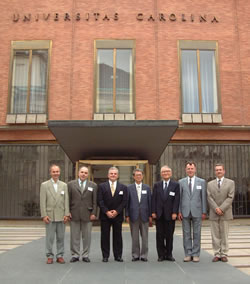|
|
Vol.
25 No. 1
January - February 2003
Electrical Properties
of Polymers and More
 |
| (From left) Professors
A. Miniewicz, J. Sworakowski, S. Nespurek (chairman),
J. -I. Jin (IUPAC representative), H. Inoguchi, N. Karl,
and J. Pfleger (cochairman) in front of the historic Carolinum
building of Charles University in Prague during the opening
day of the conference. |
by Jung-Il
Jin
The
9th International Conference on Electrical and Related Properties
of Polymers and Other Organic Solids (ERPOS) was held
in the beautiful city of Prague, Czech Republic, from 14 to
18 July 2002. The opening ceremony was held in the afternoon
of 14 July in the Carolinum, a historic building of the Charles
University in the center of the Old Town. The symposium itself
was held from 15 to 18 July in the auditorium of the Institute
of Macromolecular Chemistry (IMC) at the Academy of Sciences
of the Czech Republic, located in Heyrovskeho.
The opening ceremony began
with a welcoming speech to all participants from Professor
S. Nespurek, the conference chairman. This was followed by
speeches by Professor J. Sworakowski, a member of the International
Advisory Board, and myself acting as IUPAC Representative.
Professor J. Pfleger, the conference cochairman, led the opening
ceremony and introduced the details and itinerary of the symposium
program.
Opening lectures were given
by Professors H. Inokuchi (Japan) and N. Karl (Germany). Inokuchi
presented an excellent review of 50 years of history in organic
conductors. Karl delivered an illuminating and critical review
of recent progress in organic field-effect transistors. The
excursion through the historic rooms of the Carolinum after
the two opening lectures helped participants wash out the
tiredness accumulated by the long flight from Seoul to Prague;
not to mention all the food and wine served afterwards during
the welcome reception.
On the morning of 15 July,
Professor K. Ulbrich, director of IMC, delivered a welcoming
address before the technical session began. Ulbrich mentioned
that this particular meeting was a combination of the 9th
International Conference on ERPOS and the 21st Discussion
Conference of the Prague Meeting on Macromolecules. He pointed
out this was the 62nd Prague Meeting on Macromolecules—testament
to how deeply rooted IMC is in the history of polymer science.
In addition, there were 10
main lectures, 25 special lectures, and 90 poster presentations.
The list of the main lectures gives a glimpse of the major
topics of the conference:
- Z. G. Soos and E. V. Tsiper
(USA), Polarization Energies, Transport Gap, and Charge
Transfer States of Organic Molecular Crystals
- H.Bässler et al.
(Germany), Exciton Dissociation in Conjugated Polymers
- J. Zyss (France), Steering
Molecules by Light: From NonLinear Optics (NLO) as a Goal
to NLO as a Tool
- D. Haarer et al. (Germany),
Charge Carrier Generation and Transport in Photorefractive
Applications
- J. Kalinowski (Poland),
Recombination Radiation from Organic Solids
- N. S. Sariciftci (Austria),
Conjugated Polymer Based Solar Cells
- C. Flytzanice (France),
Nonlinear Chiro-Optical Activity in Chiral Organic Molecular
Complexes and Polymers
- J.-M. Nunzi et al. (France),
Optical Structuring of Plastic Materials for Electronics
- M. Iwamoto (Japan), Interfacial
Phenomena in Organic Polymer Films and the Generation of
Maxwell Displacement Current
- J.-I. Jin et al. (Korea),
Luminescence Properties of Novel PPV Derivatives and Low-Molar
Mass Molecules Bearing Carbazole and Oxadiazole Moieties
All of the oral presentations
were very high in scientific quality; the discussions that
followed often times were very heated. The scientific quality
of poster presentations also was very high. In particular,
the panel discussion on "From Molecular Crystals to Polymers
and Single Molecules," led by R. W. Munn (UK), J. Sworakowski
(Poland), and R. M. Metzger (USA) brought up the importance
of research cooperation among the scientists in different
disciplines. It was concluded that a conference such as this
could catalyze interdisciplinary research coworks that could
result in scientifically, as well as technically, more significant
contributions. Different approaches being taken among the
scientists in different branches also were critically discussed.
Such a panel discussion is very important in developing directions
not only for research, but also for future conferences.
The excursion to the 15th-century
Sychrov Castle and the 11th-century Detenice Chateau was memorable.
The concert of the Telleman Quartet in the chateau concert
hall took the participants to a different, more humane, and
relaxing moment for a while. The informal dinner in the castle
restaurant was another unforgettable experience.
The closing ceremony was held
18 July right after the 25th Special Lecture by G. Juska (Lithuania).
At this time it was announced that the next meeting (10th
International Conference of ERPOS) would be held in 2005 in
Angers, France. Jean-Michel Nunzi (Université d’Angers,
France) will be the organizer of the meeting.
The 9th conference was attended
by 126 participants from 24 countries; just the right size
and mix for this kind of conference on interdisciplinary research
topics. The organization was superb and the meeting went as
scheduled without a single interruption. Most of the credit
for the success of this conference should go to Stanislav
Nespurek, Jiri Pfleger, and their colleagues at the Institute
of Macromolecular Chemistry.
Jung-Il
Jin is professor at the Korea University in Seoul, Korea,
and vice president of the IUPAC Macromolecular Division.
Page
last modified 20 December 2002.
Copyright © 2002 International Union of Pure and Applied
Chemistry.
Questions regarding the website, please contact [email protected]
|